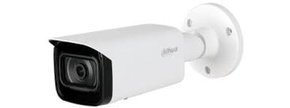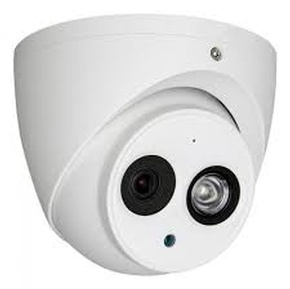A bullet camera is a surveillance camera that has a cylindrical shape that resembles a bullet. They can range in size from your typical mall camera down to a much smaller version that is only a couple of inches long. These smaller versions are called lipstick cameras. Bullet cameras can be mounted virtually anywhere.
Conventional bullet cameras are powerful and come in all types of resolutions. Also available in fixed vs. varifocal lenses which can change the zoom level. Bullets are generally “higher profile” and serve as a good deterrent to alert would-be prowlers of your video surveillance system. While typically easier to install than domes, they also can be tampered with more easily because moving them physically moves the lens and the image.
Bullet cameras are named for their distinct cylindrical shape, resembling a bullet. These cameras act as a visible deterrent and research has shown that the presence of bullet cameras makes a property less desirable to a criminal. These security cameras operate both indoors and outdoors and have features such as a small lip on the tip of the lens to protect against any glare or other weather. Below are the main advantages of installing a bullet camera.
Bullet camera range is much longer than other cameras, which positions them as ideal options for large areas such as parking lots or backyards. Their field of view is fairly narrow, yet the shape of the camera allows for a larger lens on the bullet camera than a dome camera. Long-distance viewing is the bullet camera’s main strength. The camera’s narrow viewing angle allows the camera to see clearly at farther distances, similar to how a pair of binoculars work. Often, the cameras are good at capturing clear images of people and license plates at great distances, making it easy for someone to identify such things if they look back through the footage.

Dome cameras get their name from their dome-shaped structure. These security cameras are designed to withstand all elements, both inside and outside. Their construction allows for the camera to work even in low-light or no-light settings due to the built-in infrared LEDs. Dome cameras get their name from their dome-shaped structure. These security cameras are designed to withstand all elements, both inside and outside. Their construction allows for the camera to work even in low-light or no-light settings due to the built-in infrared LEDs.
Its dome makes it suitable for places where you don’t want people to be able to tell where the camera is facing. On the other hand, turret cameras have a stronger night vision and a lack of a dome which makes them suited to places where you want to have as much clarity as possible.
One of the main benefits of a dome camera is that the dome can make it difficult to determine where the camera is pointing. In addition, dome cameras are generally more durable and resistant to vandalism as the camera lens is protected. There are also vandal proof dome cameras which are encased with durable covers that are resistant to general acts of vandalism. In comparison, bullet cameras can be knocked off or manually repositioned to point in another direction. The shape and design of dome cameras allow you to monitor a wider angle as the lens moves versus bullet cameras only point in one direction.
Its dome makes it suitable for places where you don’t want people to be able to tell where the camera is facing. On the other hand, turret cameras have a stronger night vision and a lack of a dome which makes them suited to places where you want to have as much clarity as possible.
One of the main benefits of a dome camera is that the dome can make it difficult to determine where the camera is pointing. In addition, dome cameras are generally more durable and resistant to vandalism as the camera lens is protected. There are also vandal proof dome cameras which are encased with durable covers that are resistant to general acts of vandalism. In comparison, bullet cameras can be knocked off or manually repositioned to point in another direction. The shape and design of dome cameras allow you to monitor a wider angle as the lens moves versus bullet cameras only point in one direction.
Key Dome Camera Advantages:

Here are a few key differences between Bullets and Dome cameras:
Dome cameras are installed indoors or outdoors and can hang from the ceiling or be mounted on walls. Although dome security cameras are less visible, they are slightly more challenging to install than bullet cameras, although not by much. A minor inconvenience is that dome cameras must be remounted if you want to change the field of view, whereas you can usually reposition the bullet camera (provided the area you want to view is within the camera’s range).
Also installed both inside and outside, bullet cameras are typically mounted to the side of the wall. Bullet cameras are easier to install because they come with a mounting handle. Once installed, you can easily position the camera lens to monitor the area you want the camera to view.
Several things influence a camera’s range, including its sensor chip, the type of lens, wide range dynamic, lines of resolution, and backlight compensation. While it will largely depend on the exact camera chosen, in general, dome cameras have smaller lenses than bullet cameras, as the shape of a bullet camera makes it easier to accommodate a larger lens. As such, bullet cameras are more suitable for areas that require a camera with a longer range.
While light is usually a primary consideration with any camera, the good news here is that both bullet and dome cameras often include infrared LEDs that ensure light availability isn’t as big of a factor. The infrared LEDs ensure that the cameras can perform in low light situations.
Although the differences between dome and bullet cameras are relatively minor, they are important to understand when selecting your security cameras. The general perception is that if you want overt security, to send a message to would-be intruders that you have security, then bullet cameras are the way to go. However, the best security system often includes a mix of both dome and bullet cameras, allowing you to monitor all angles of your property, indoors and out.
In addition, there are a few features that are critical to both cameras that you should also consider. Essential features of modern security cameras are wireless versus wired, Infrared (IR) technology, and night vision. Most of Swann’s dome and bullet security cameras include Infrared (IR) thermal sensing and night vision helping you monitor your property day or night. Learn more about these features from our security experts in the article

LiveSmart Technologies was founded by Gary Russell, a systems engineer and program manager executive with 40 years of experience developing solutions to complex technological challenges. Such is the case with modern home automation and its multiple protocols, brands and software. LiveSmart is proud to bring this capability to California.
California State Contractor’s License #1100854
Copyright LiveSmart Technologies.